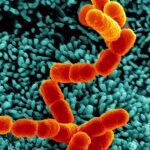Lien vers Pubmed [PMID] – 1989796
Chest 1991 Feb;99(2):363-9
Amiodarone (A) is a widely-used antiarrhythmic drug. Pulmonary toxicity is the most serious adverse effect with an estimated mortality of 1 to 33 percent. In order to determine an element helpful for diagnosis, we examined four patients with amiodarone-induced pulmonary toxicity, three patients treated with A, without evidence of pulmonary toxicity but with a main underlying pulmonary disease, and four healthy volunteers. Daily and cumulative doses or duration of treatment were similar in the first two groups. Pulmonary function tests (spirometry, CO-diffusing capacity, arterial blood gases), roentgenographic examinations, pulmonary biopsies or immunoallergologic tests (skin reaction, lymphoblastic transformation test and human basophile degranulation test) did not provide any discriminatory element. In APT+, we observed an increased cellularity of the bronchoalveolar lavage. Neither the differential cell count nor the presence of foamy macrophages were distinguishable between APT+ and APT-. The phospholipid composition of BAL fluid showed a decreased total phospholipid and phospholipid/protein ratio in all patients compared to normal subjects. These changes reflect more the severity of pulmonary disease than the specificity of the causative agent. However, we observed that the unique PL which decreases in APT- and remains normal in APT+ is phosphatidyl-serine + phosphatidylinositol (PS + PI). This has to be confirmed and should be evaluated at different stages of the disease to determine an eventual specific element. We conclude that there are no data currently available to establish the diagnosis of APT except perhaps for the analysis of BAL PL content.

